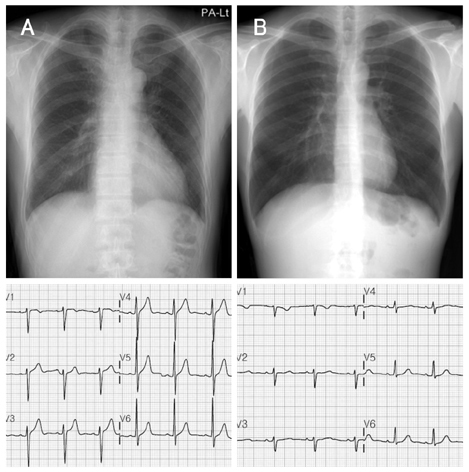Korean Circ J.
2009 Oct;39(10):418-422. 10.4070/kcj.2009.39.10.418.
Prevalence and Positive Predictive Value of Poor R-Wave Progression and Impact of the Cardiothoracic Ratio
- Affiliations
-
- 1Department of Internal Medicine, University of Ulsan College of Medicine, Seoul, Korea. youho@amc.seoul.kr
- 2Center for Clinical Service, National Cancer Center, Goyang, Korea.
- KMID: 2028922
- DOI: http://doi.org/10.4070/kcj.2009.39.10.418
Abstract
- BACKGROUND AND OBJECTIVES
Poor R-wave progression (PRWP) is a common electrocardiographic diagnosis. However, the diagnostic usefulness of PRWP for coronary artery disease (CAD) and the plausible explanation for subjects with normal heart function are unclear. SUBJECTS AND METHODS: We included 20,739 subjects who had routine medical examinations and applied the commonly used criteria (R-waves in V3 or V4 < or =2 mm) and the Marquette criteria in the current study. Subjects with PRWP by the Marquette criteria, but with no evidence of specific causes, were identified. Healthy age- and gender-matched controls were selected randomly for comparing cardiothoracic ratios. RESULTS: The commonly used criteria in practice were met by 372 of the 20,739 subjects (1.8%). The Marquette criteria were met by 96 subjects (0.5%), and 82 of who agreed to medical evaluation. Five subjects had known CAD and only one subject was shown to have a silent myocardial infarction by additional testing. Therefore, the positive predictive value of PRWP for CAD was 7.3% (6/82) based on the Marquette criteria. As compared with the control group, the subjects with PRWP had a significantly low cardiothoracic ratio (0.425 vs. 0.445, p<0.05), especially among the male group (0.454 vs. 0.407, p=0.02). CONCLUSION: The positive predictive value of PRWP for CAD in the general population is so low that additional tests for diagnosis may be unreasonable. In addition, a low cardiothoracic ratio could be a plausible explanation of PRWP in subjects without any identifiable cause.
MeSH Terms
Figure
Reference
-
1. Physician's Guide to Marquette Electronics Resting ECG Analysis. 1991. Milwaukee, Wis: Marquette Electronics Inc.2. DePace NL, Colby J, Hakki AH, Manno B, Horowitz LN, Iskandrian AS. Poor R wave progression in the precordial leads: clinical implications for the diagnosis of myocardial infarction. J Am Coll Cardiol. 1983. 2:1073–1079.3. Wagner A, Mahrholdt H, Holly TA, et al. Contrast-enhanced MRI and routine single photon emission computed tomography (SPECT) perfusion imaging for detection of subendocardial myocardial infarcts: an imaging study. Lancet. 2003. 361:374–379.4. Zema MJ, Collins M, Alonso DR, Kligfield P. Electrocardiographic poor R-wave progression: correlation with postmortem findings. Chest. 1981. 79:195–200.5. Joo IJ, Hur DY, Kim ES, et al. Differential diagnosis in cases showeing poor R-wave progression on EKG by ventorcardiography. Korean Circ J. 1986. 16:349–356.6. Won KH, Chang MY, Oh KS, Kim YC, Lee HC. Clinical observation on poor R-wave progression. Korean Circ J. 1983. 13:195–201.7. Wagner GS. Marriott's Practical Electrocardiography. 2001. 10th ed. Philadelphia, PA: Lippincott Williams & Wilkins.8. Zema MJ, Kligfield P. Electrocardiographic poor R wave progression: I. correlation with the Frank vectorcardiogram. J Electrocardiol. 1979. 12:3–10.9. Zaman MJ, Sanders J, Crook AM, et al. Cardiothoracic ratio within the "normal" range independently predicts mortality in patients undergoing coronary angiography. Heart. 2007. 93:491–494.10. Feldman T, Borow KM, Neumann A, Lang RM, Childers RW. Relation of electrocardiographic R-wave amplitude to changes in left ventricular chamber size and position in normal subjects. Am J Cardiol. 1985. 55:1168–1174.11. Sugita S, Takada K, Takada H, Nagashima M, Hayano J. The relationship between R amplitude in lead V5 (RV5) and left ventricular mass in the groups of adolescent subjects classified by body composition. Jpn Circ J. 1998. 62:893–899.12. Gami AS, Holly TA, Rosenthal JE. Electrocardiographic poor R-wave progression: analysis of multiple criteria reveals little usefulness. Am Heart J. 2004. 148:80–85.13. Sigurdsson E, Thorgeirsson G, Sigvaldason H, Sigfusson N. Unrecognized myocardial infarction: epidemiology, clinical characteristics, and the prognostic role of angina pectoris. Ann Intern Med. 1995. 122:96–102.14. Kannel WB, Cupples LA, Gagnon DR. Incidence, precursors and prognosis of unrecognized myocardial infarction. Adv Cardiol. 1990. 37:202–214.
- Full Text Links
- Actions
-
Cited
- CITED
-
- Close
- Share
- Similar articles
-
- A study on computed tomography cardiothoracic ratio in predicting left ventricular systolic dysfunction
- Clinical Observation on Poor R-Wave Progression
- The Different Inspiratory Pressure Waves in Variuos I:E Ratio : Comparison of the Oxygenation and Ventilation in F1O2 1.0
- A CT Criteria of Cardiomegaly
- Impact of Glycemic Control and Metformin Use on the Recurrence and Progression of Non-Muscle Invasive Bladder Cancer in Patients with Diabetes Mellitus



